|
The Opening of the Railway
Although not realised at the time, the opening of the
Grand Junction Railway, and James Bridge station was to
have a dramatic effect on the fortunes of industry in
Darlaston. Initially the railway only catered for
passengers, until six months after opening, when goods
traffic was introduced. This had a great impact on
Darlaston’s fortunes which had been in decline for many
years.
The town relied heavily on the gun trade, but after the
Napoleonic wars demand fell, and Darlaston went into a
severe depression, which lasted around twenty years. The
introduction of goods traffic changed everything.
Industry flourished, raw materials and machinery could
easily be transported to the factories, and finished
products were distributed far and wide. |
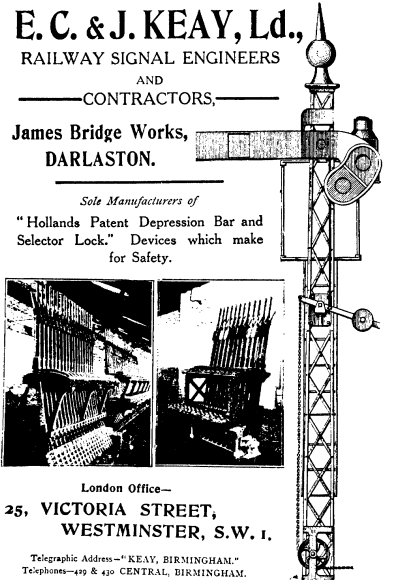
Keay's were one of the many
Darlaston manufacturers that greatly benefited as
suppliers to the railway companies. |
The world’s first long-distance railway, the Grand
Junction Railway, opened on the 4th July 1837. The 82
miles of track ran from Birmingham to Newton Junction on
the Liverpool and Manchester Railway.
The line ran through the Black Country with stations
at Perry Barr, Newton Road, Bescot Bridge, James Bridge,
Willenhall, and Wednesfield Heath (for Wolverhampton),
then on to Stafford, Crewe and the north.
Due to the hilly nature of the town, much of the line
through Darlaston had to laid in a cutting, roughly
between Bentley Road South and James Bridge Cemetery.
Road bridges crossing the line were built in the
Crescent, Bentley Road South, Kendricks Road, and
Walsall Road.
During the last phase of construction there would
have been a lot of activity on the section which is now
alongside James Bridge Cemetery.
The Walsall Canal is carried over the railway cutting
across a small aqueduct, built of brick and stone, lying
at an angle to the cutting, and known as the Bentley
Aqueduct. During construction a temporary canal was
built for the passage of boats. |

An early Grand Junction Railway train,
with some outside passengers.
| When the work had been completed, and the diversion
removed, it was found that the cast iron liner in the
aqueduct leaked in several places. The canal had to be
diverted again, and the leaks fixed. With great
difficulty the liner was made watertight, but by this
time work on the remainder of the line had been
completed. So Bentley Aqueduct became the last feature
on the line to be finished. The opening of the line
caused great excitement. Large numbers of sightseers
flocked to watch the progress of the first train, which
consisted of eight carriages hauled by an engine called
‘Wildfire’. James Bridge must have been awash with
people, who came to watch the train, travelling faster
than anything they had seen before, reaching speeds of
up to 40 miles an hour. |

The arrival of a holiday excursion train
at James Bridge Station in 1906.
|
When operation began, six trains
travelled along the line daily, from each direction.
Four of them had only first class carriages, the other
two had first and second class carriages. James Bridge,
like the other four stations between Birmingham and
Wednesfield Heath was a second class station, so only
trains with second class carriages stopped there.
Initially the only trains to call at James Bridge were
the 9.03 a.m. and the 5.33 p.m. from Birmingham, and the
1.26 p.m. and the 9.26 p.m. from Manchester and
Liverpool. No trains with second class carriages ran on
a Sunday.
One of the earliest accidents on
the railway occurred near Bentley when a horse got onto
the line from a nearby field. It collided with a
locomotive, which was derailed, and ended-up in a field.
The accident killed the driver, and several horses that
were in a horse box. As a result of the accident, the
fences alongside the track were improved.
In the first two months of
operation over 5,000 first class, and nearly 4,300
second class passengers travelled from various stations
to Birmingham. Ticket sales amounted to just over
£2,191. A lot of money at the time. |
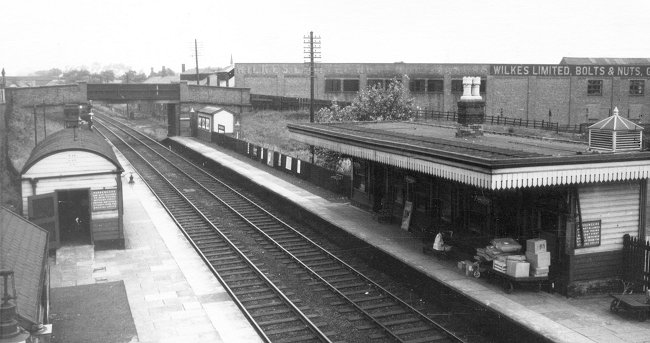
A later view of the station.
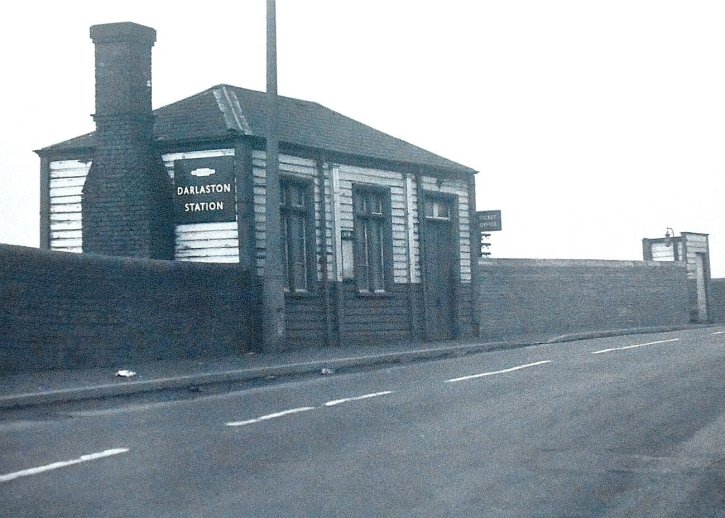
The station entrance on the railway
bridge.
|
In 1846 the railway merged with the
London & Birmingham Railway, and the Manchester and
Birmingham Railway, to form the London and North Western
Railway, which had an even greater impact on local
industry. This can be seen in the names chosen for two
nut and bolt companies that opened shortly after the
railway was built. They were the Grand Junction Works at
James Bridge, and the London & North Western Works on
Bentley Road.
James Bridge Station also had a
station hotel in the form of the Railway Tavern. The pub
originally opened in the mid 1840s as the James Bridge
Hotel, but has now sadly gone.
The station became very popular,
but passenger numbers declined as public transport on
the roads improved. Many people will remember the summer
excursions by train that began at the station, often
organised by local factories. Although passenger numbers
declined, the railway carried a lot of goods traffic,
and was essential for many manufacturers. James Bridge
Station closed in January 1965, and all traces of it
have now disappeared. The railway itself is still an
important link between Wolverhampton and Birmingham, and
hopefully will continue in service for many years to
come. |
|

The railway station in its
later years. |
|
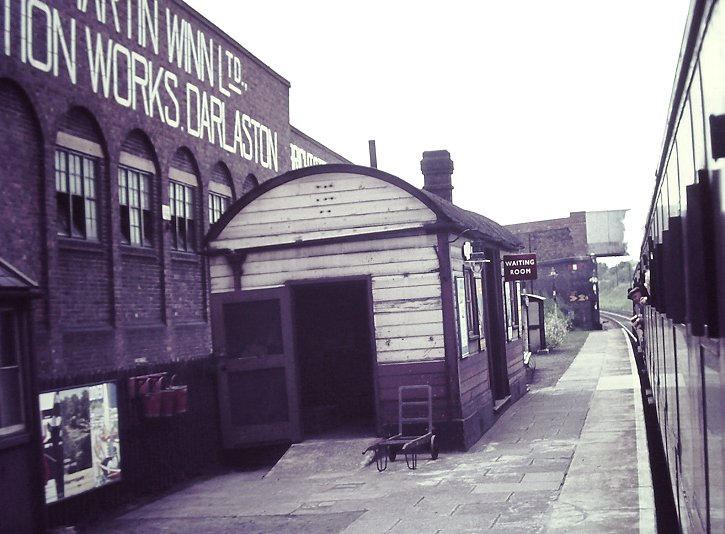
The railway station
waiting room. |
|
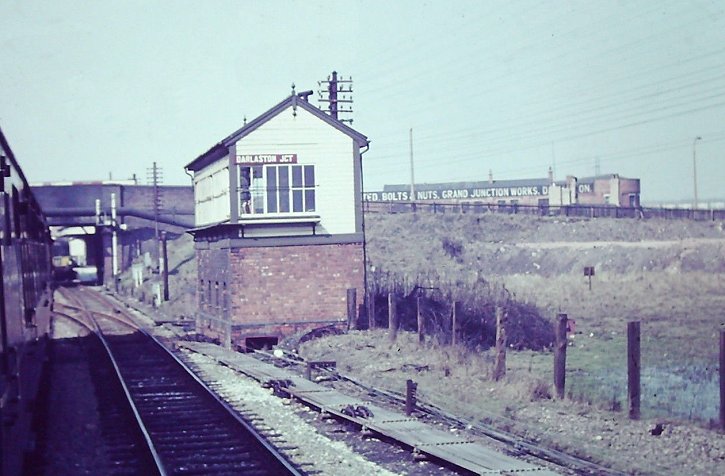
The signal box. |
| Darlaston's Other
Railway Station In 1863 the South Staffordshire Railway Company
opened the Darlaston Branch which ran from a junction
with the London & North Western Railway at James Bridge,
through Darlaston town centre, to a junction close to
Wednesbury Town Station, on the line from Walsall to
Dudley.
It included
Darlaston Town Station, situated in the cutting between
the Walsall Road, and Darlaston Road.
The station became very popular with passengers, and
by 1869 there were nineteen trains running daily, each
way from the station. Many people commuted to and from
Darlaston, and large amounts of goods were transported
day and night, serving many factories along the route.
Unfortunately as far as I know,
there are no surviving photographs or drawings of
Darlaston Town station. It would have been built of
wood, possibly with wooden platforms. |
 |
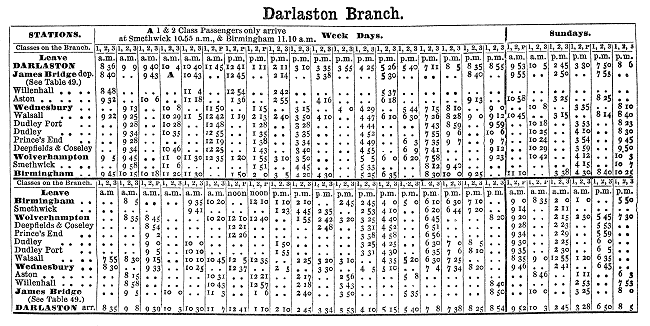
A timetable from August 1869, including
the trains that called at Darlaston Town Station.

An impression of how the station might
have looked, based on the railway company's standard buildings.
| In 1867 the South Staffordshire Railway became part
of the London and North Western Railway.
All was well until the introduction of steam trams by
the South Staffordshire & Birmingham District Steam
Tramways Company, in 1883. People preferred to travel by
tram, and the branch claimed to have lost £6,000 in
passenger traffic between 1883 and 1886. In 1887 the
passenger service was withdrawn, and the local authority
and local businessmen attempted to get the service
reinstated via the courts.
Darlaston Local Board, the
forerunner of Darlaston Urban District Council, applied
to the Railway Commissioners to have the service
restored. The Commissioners agreed, but by that time the
railway company had demolished the station buildings and
removed the platforms, obliterating all traces of them.
The London & North Western Railway appealed to the High
Court, which ruled that the Commissioners had no power
to make such an order. In December 1893 Darlaston Local
Board took the railway company to the High Court, but
lost the case. The court ruled that the service could
only be provided if the railway company chose to do so. |
|
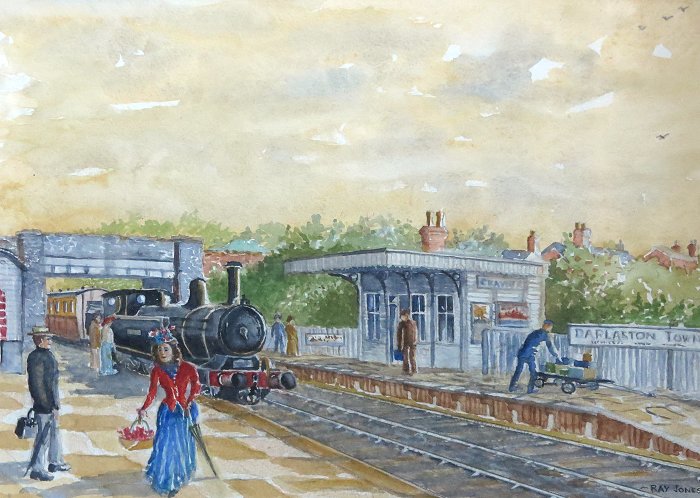
A fine painting by Ray Jones
showing how the station may have looked. |
|
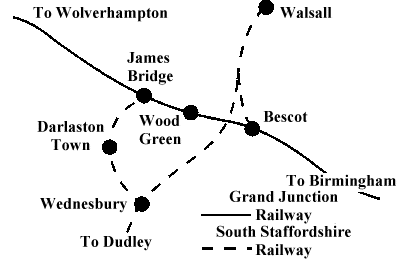
The original railways that passed
through Darlaston. |
Although passenger traffic ceased,
the line became an essential link between local
companies and the railway network.
It carried a lot of goods traffic
to and from many factories including the iron works at
Darlaston Green, W. Martin Winn & Company, Charles
Richards & Sons Limited, GKN, Old Park Works, and the
Patent Shaft & Axletree Company. |
| The line continued to be heavily used until the
1950s when road traffic started to dominate. It closed
in the mid 1960s at the time of the Beeching cuts. All
that remains of the line today is the footpath from
Heath Road to Darlaston Road. The only surviving
features are the Bull Street, and Walsall Road bridges,
the remains of Darlaston Road bridge, and the cutting
that runs alongside Victoria Road, and Crescent Road,
extending to Darlaston Road. Many people fondly remember
Mason’s paper shop in Pinfold Street, but few will
remember the time when it was a London & North Western
Railway parcels receiving office.
Ironically, the coke for the steam trams, which caused
the decline in the number of railway passengers, was
delivered by the railway to a special siding that ran up
the side of the cutting above Darlaston Town Station to
the adjacent tram depot and headquarters. On the site
were extensive tram sheds, workshops, offices, and the
general manager's house. Electric trams were introduced
in 1893, and the company was taken over by the British
Electric Traction Company. The Darlaston Depot closed in
1930. A short section of preserved track could be seen
until recent times in the road leading to Charles
Clark's parts and service department. |
| Contemporary accounts of life in Darlaston in the
first half of the 19th century are very few and far
between. Two railway guide books were written in 1838,
both of which include descriptions of Darlaston. These
accounts were written by comparatively wealthy
travellers, to whom visiting Darlaston must have been
like visiting another world. Even allowing for this they
are still of great interest. |
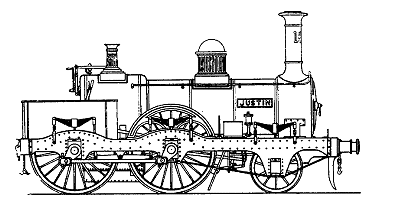
| South
Staffordshire Railway locomotive number 181
Justin. Built by E. B. Wilson. |
|
| The first of these is Drake's Road Book of the
Grand Junction Railway which includes the following:
The high road from Walsall crosses here to
Darlaston, (seen in the distance on the W.,) another
town in the iron and coal district. The chief
manufacturers of this, as of the neighbouring towns,
consist of various iron and steel goods. The whole
district is abundantly traversed by canals,
tram-roads, &c., for the convenient conveyance of
merchandise, and presents to the passing traveller
less subject for praise in point of beauty, than for
admiration and surprise, at the closely-placed
engines, mills, coal-pits, iron mines, and
factories, which greet him on all sides, with
hissing, curling volumes of white steam, or thick
massy clouds of rolling smoke. Should the traveller
journey through this strange neighbourhood by night,
the novel and wild, not to say, grand, effect of the
fires, must strike him forcibly. Huge furnaces
glowing on the earth, from a dark wayside forge;
tall chimneys, themselves not seen in the gloom,
vomiting forth flames and fiery-coloured smoke, or a
long range of glowing hillocks, where flickering
blazes play from charcoal burning within; add to
these, the dusky figures of the men and boys
employed in the works, and a stranger will have a
scene before him, in which the "fearsome" is oddly
enough blended with the grotesque. |
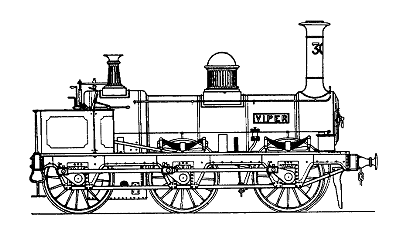
| South
Staffordshire Railway locomotive number 301
Viper. Built by E. B. Wilson. |
|
The second account is from Osborne's Guide to the
Grand Junction Railway, which includes a longer
description:
To the west, about a mile from the line, is the town
of Darlaston, a part of the mining district. The town is
situated on a hill, and from a distance looks very well;
but as we approach it, there is more appearance of
actual wretchedness and degradation than in any other
part of the mining district. The buildings are almost
all small houses for the workmen, and their workshops;
and the place is as uncouth and rough in appearance, as
if there were no town within a hundred miles. Many of
the streets are as unattended to as the lanes and byways
of a farmhouse, the mud and dirt actually obstructing
the passage. The people and the houses of Wednesbury are
dirty, and unattended to; but in Darlaston they seem to
have little or nothing to attend. There is a plain-built
large church, in modern chapel-of-ease style, which was
erected by subscription. The living is worth £200 or
£300 a year, and is in the gift of the executors of the
celebrated late Rev. C. Simeon, of Cambridge.
There is a Wesleyan Methodist Church, an Independent
Chapel, and a magnificent Primitive Methodist chapel.
This last building is one of the largest and best
constructed edifices of the kind in the country. There
are Sunday Schools connected with each place of worship,
but there are no public and but very few private day
schools, and therefore there is scarcely any means of
instruction for the great mass of the population.
The manufacture of the place is gun locks, a branch
of business which, during the war, was so profitable
that a good workman could get a pound note per day.
Granting a considerable allowance for the depreciation
of paper money, yet the profitable employment in making
gun locks was such, that by working only two days a
week, the men could obtain as much as would supply their
wants, and find them the means of enjoying the only
luxury they seemed to know - that of drinking four days
a week - which they used to indulge, out of loyalty to
their own country, and hatred to France. |
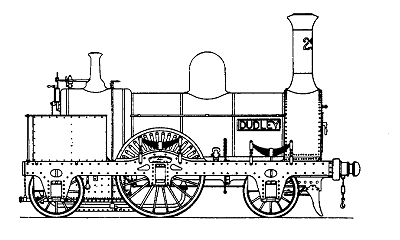
South
Staffordshire Railway locomotive
number 297 Dudley.
Built by W. Fairbairn & Sons. |
During the war, these Darlaston gun lock makers
used to live in the most luxurious and extravagant
manner. Such was their demand for poultry, fish, and
meat, that Darlaston became the most profitable market
for these things in the neighbourhood. Most of the men
might have made fortunes in the days of prosperity, but
they not only spent what they obtained extravagantly,
but refused to work more than one or two days a week.
During this belligerent carnival the people sunk even
lower than before in vice and immorality, and not one
particle of what can be denominated personal or
household comfort, was obtained. Bull-baiting, dog and
cockfighting, and all sorts of low and debased
practices, were the amusements they indulged in, while
swearing, cursing, and disgustingly foul language,
seemed to grow with their prosperity. At length the war
ceased. Suddenly the trade of the place fell away. The
workmen, instead of being able to get a pound per day,
could only obtain three or four shillings, or less, and
very frequently he had no work at all. The greatest
misery prevailed; those who had previously breakfasted
even on turkey, chicken, or rabbit, were now glad to get
a bit of bread and bacon, or cheese. Many who used to
drink a bottle of wine at dinner, now could not get half
a pint of beer. The poor ignorant and mistaken creatures
were accustomed to curse the peace, and abuse their
employers, and work hard and close in sullenness and
misery.
Millions of gun locks have been made here for the
purpose of destroying our fellow creatures. During the
French war, gun locks were worth from 8shillings to
15shillings each, and a good workman could get up two in
a day. Now they are 3shillings and 6pence, or
4shillings, and so much more work in them is required,
that a man cannot make more than one a day. The workmen
are incredibly ingenious, being able to forge almost
anything on the anvil. There is no doubt that they would
forge iron images on the anvil, as well as the statuary
cuts them in marble, if they had orders for them.
Great quantities of iron, coal, and free stone, are
found in this neighbourhood. Steel furnaces and forges
are here for the supply of steel for the locks and
springs which are made. The ground has been so
undermined, that pits are constantly being made in the
earth in all directions, by the falling in of the mines,
when the pillars are taken down; and consequently most
of the houses are built low, in order that they may
accommodate themselves to the sinking of the ground.
The language and terms which the workmen adopt, when the
endeavour to explain anything, is such as but few
persons can understand. Barbarisms, such as "Um thinks
as it's gooden like for wae"-"Us does the work for
they"-"Us have the wark to daew when em awhants it
deunne wael, far nobbodee abaen here cono daou iten bun
wae" are very common. To hear them talk of their great
works, their pits, and mines, everything is alive and
acting. A pit carries a shaft (the way down) a hundred
yards deep. She (for it is generally feminine) uses so
many men and horses. The coal runs itself out at such a
place; or the rock, or gob, (a term for the clayey kind
of stone) eats it out. It spends itself in a certain
direction. If goes, it comes, it stops, it breaks, it
overruns, it lets us know, and does everything which a
being can do. The men are as proud of their pits and
mines as if they were their own estates. Each one has
his own part of the mine in which he works, and she is
his wife. He works with her, and for her, and she seems
to possess his entire soul and body.
The following colloquy may be taken as a good specimen
of their social language. It was heard near to Dudley,
between a woman who was standing at her house door, and
a neighbour who was passing by on her road to market.
"Oi say, where be'est thee a gwain?" "Oi been a gwain to
Dudley." "What be'est a gwain to Dudley fir?" "Oi been a
gwain to fetch a ship's yead and pluck." "Oi say, thee
bring me one wut?" "E'es oi wull." "An moind au dunna
forgit the brains, our divil looves brains." "Noa, oi
wunna."
The women, even the young ones, seem to lose their
natural symmetry very early, and their mode of dress is
so generally uncouth that they appear to be neither men
or women. That there are plenty of women, the number of
children, which we see, proves; but both father, mother,
and children, seem to be without education or attention.
The children play in the streets from the time that they
can run till they go to the pit or the shop, and there
they work till they have children themselves to do the
same thing again. There cannot be a place in the kingdom
more deserving of the attention of educational men than
the mining district of Staffordshire. |
 |
 |
 |
Return to
Increasing Population |
Return to
Contents |
Proceed to Years
of Growth |
|